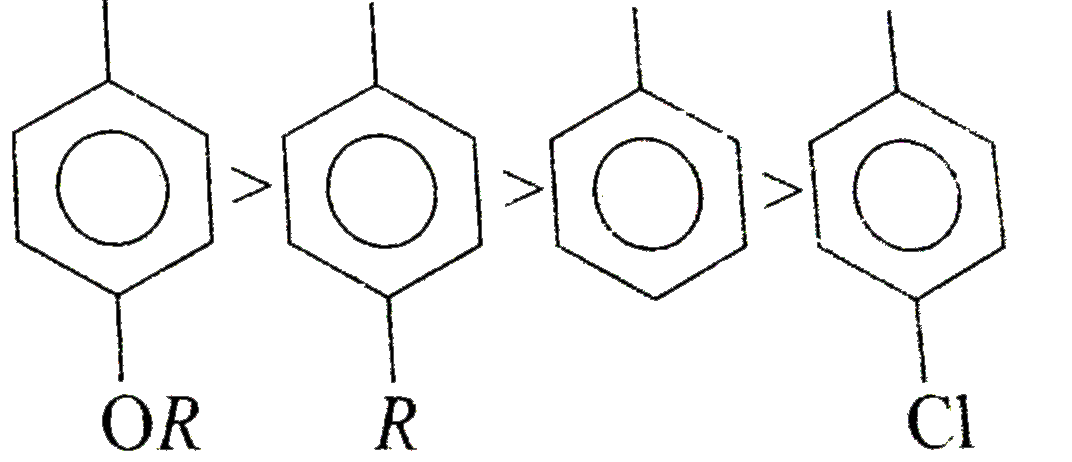Acid catalysed conversion of 1,2-diol or vicinal diol, into carbonyl compound known as pinacol-pinacolone rearrangement.

Generally more electron donating group migrate during mechanism, migration of -H is faster because of its smaller size.

Which of the following is not correct about this rearrangemet?
Migratory order for substituent in phenyl is 
The carbocation is stabilised by 1,2-shift
Migratory aptitude for substituent is in R−>H−>C6H5
Product of reaction is carbonyl compound
The correct Answer is:C
Migratory aptitude for substituent is in R−>H−>C6H5
Similar Questions
Acid catalysed conversion of 1,2-diol or vicinal diol, into carbonyl compound known as pinacol-pinacolone rearrangement.

Generally more electron donating group migrate during mechanism, migration of -H is faster because of its smaller size.

What would be the major product of reaction?
View SolutionAcid catalysed conversion of 1,2-diol or vicinal diol, into carbonyl compound known as pinacol-pinacolone rearrangement.

Generally more electron donating group migrate during mechanism, migration of -H is faster because of its smaller size.


In this sequence of reaction final product is :
View Solution
Knowledge Check
Acid catalysed conversation of 1,2-diol or vicinal, into carbonyl compound known as pinocaol-pinacolone rearrangement.

Generally more electron donating group migrate during mechanism, migration of H is faster because of its smaller size.
Which of the following is not correct about this rearrangement?A BThe carboncation is stabilised by 1,2-shiftCMigration aptitude for substituent is in R−>H−>C6H5DProduct of reaction is carbonyl compound.
BThe carboncation is stabilised by 1,2-shiftCMigration aptitude for substituent is in R−>H−>C6H5DProduct of reaction is carbonyl compound.Acid catalysed conversation of 1,2-diol or vicinal, into carbonyl compound known as pinocaol-pinacolone rearrangement.

Generally more electron donating group migrate during mechanism, migration of H is faster because of its smaller size.
Which of the following is not correct about this rearrangement?A BThe carboncation is stabilised by 1,2-shiftCMigration aptitude for substituent is in R−>H−>C6H5DProduct of reaction is carbonyl compound.
BThe carboncation is stabilised by 1,2-shiftCMigration aptitude for substituent is in R−>H−>C6H5DProduct of reaction is carbonyl compound.Acid catalysed conversion of 1,2-diol or vicinal diol, into carbonyl compound known as pinacol-pinacolone rearrangement.

Generally more electron donating group migrate during mechanism, migration of –H is faster because of its smaller size.


In this sequence of reaction final product isA B
B C
C D
D
Acid catalysed conversation of 1,2-diol or vicinal, into carbonyl compound known as pinocaol-pinacolone rearrangement.

Generally more electron donating group migrate during mechanism, migration of H is faster because of its smaller size.
What would be the major product of reaction?

View SolutionAcid catalysed conversation of 1,2-diol or vicinal, into carbonyl compound known as pinocaol-pinacolone rearrangement.

Generally more electron donating group migrate during mechanism, migration of H is faster because of its smaller size.

In this sequence of reaction final product is"
View SolutionA reaction characteristic of vicinal diols is their oxidative cleavage on treatment with periodic acid (HIO4). The carbon-carbon bond of the vicinal diol uinit is broken and two carbonyl groups result. Periodic acid is reduced to iodic acid (HIO3)

Cyclic diols react to give dicarbonyl compounds. The reactions are faster when the hydroxyl gorups are cid than when they are trans but both stereoisomers are oxidised by periodic acid. Periodic acid cleavage of vicinal diols is often used for analytic purposes as an aid in structure determination. By identifying the carbonyl compounds produced, The constitution of the diol may be deduced.
Which of the following products is/are obtained when glycerol is treated with HIO4 ?
View SolutionUnder common reaction conditions, a carbocation rearranges to another carbocation of equal or greater stability. For example, a secondary carbocation will rearrange to a tertiary carbocation. It will not rearrange to a less stable primary carbocation. This generalization is not absolute, and because there is not a high energy barrier to the rearrangement of carbocations, rearrangement to a less stable cation can occur if it offers the chance to form a more stable product.
In the following cation, H/CH3 that is most likely to migrate to the positively charged carbon is :
H3C1−H∣2C∣OH−⊕3C∣H−H∣4C∣CH3−5CH3
View SolutionDuring neutralisation of an acid by a base, the end point refers for the completion of reaction. The detection of end point in acid -base neutralisation is usually made by an acid-base indicator. An acid-base indicator is itself a weak acid (Phenolphthlein) or a weak base (Mrthyl orange). At about 50% ionisation which depends on the medium, the anion furnished by an indicator (acid) or cation furnished by indicator (basic) imparts its characteristic colour to solution at point. For example phenolphthalein, the dissociation is
HIn⇔H+Colourless+In−Pink,KHIn=[H+][In−][HIn]
favoured in presence of alkali and pink colour of phenolphalein ion is noticed as soon as the medium changes to alkaline nature. The end point of acid-base neutralisation not necessarily coincides with equivalent point but it is closer and closer to equivalence point. Also at equivalence point of acid-base neutralisation pH is not necessarliy equal to 7.
Which of the following statements are correct ?
(1) Phenolphthalein is not a good indicator for weak alkali titrations
(2) Phenolphthalein does not give pink colour with weak alkalies as NH4OH
(3) Phenolphthalein is an acid indicator and imparts colour in basic medium
(4) Phenolphthalein is a basic indicator and imparts colour in basic medium
(5) Phenolphthalein furnishes coloured cation
View Solution
